Brought to you by

Overall, our 47-strong judging panel lodged 573 scores for 118 different courses up and down the country. They visit and score courses on seven criteria:
Shot Values (score out of 20): How well do the holes pose a variety of risks and rewards and equally test length, accuracy and finesse?
Resistance to Scoring (out of 10): How difficult, while still being fair, is the course for a scratch player from the back tees?
Design Variety (out of 10): How varied are the holes in differing lengths, configurations, hazard placements, green shapes and green contours?
Memorability (out of 10): How well do the design features provide individuality to each hole yet a collective continuity to the entire 18?
Aesthetics (out of 10): How well do the scenic values of the course add to the pleasure of a round?
Conditioning (out of 10): How firm, fast and rolling were the fairways, how firm yet receptive were the greens and how true were the roll of putts on the day you played the course?
Ambience (out of 10): How well does the overall feel and atmosphere of the course reflect or uphold the traditional values of the game?
To arrive at a course’s final score, we total its averages in the seven categories, doubling Shot Values to create a score out of 80.
For their time and input, we thank our national panel of judges: Brett Allan, Scott Ball, Ginny Bolderston, Steve Brent, Bob Brereton, Geoff Burns, Ian Charlton, Terry Cochrane, Dan Crook, Paul Dunn, Ray Ellis, Michael Goldstein, Ryan Green, Carl Hadler, Nicholas Healy, Tolan Henderson, Raymond Hinton, Macaulay Howell, Chris Hunt, Andrew Jackson, Regan Johnston, Ray Jones, Erik Jorgensen, Loren Justins, Devon Kay, Steve Keipert, William Leipnik, Kerry Manderson, Regan McCaffery, Richard Middleton, John Murcott, William Owen, James Pearson, Gerald Ponsford, Mike Reid, Tim Richards, David Ross, Tim Ross, Philip Sheehan, Andrew Sloane, Jonathan Smith, Mike Smith, Tom Starr, Mike Wharepouri, Anaru White, Adam Williams and Michael Williams.
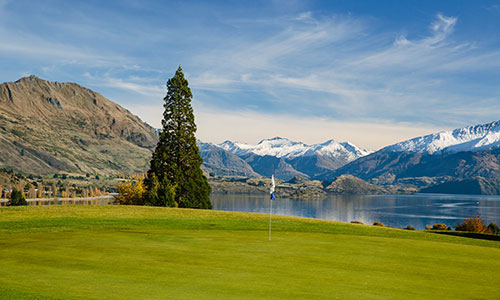
50: Wanaka
The last course to sneak into our debut ranking is Wanaka Golf Club. The course ranks high on any “enjoyability” scale, as the views of the surrounding mountains and lake make this one of the most photographed courses in New Zealand. The long par-4 finishing hole is a standout, tempting you to cut the corner and punishing any failure to do so, as you play a long second shot to a very small green.

49: St Clair
At well over 100 years old, St Clair Golf Club in Dunedin is a clifftop layout sitting high above the Pacific Ocean. Amazingly, the course’s fairways have been graced by the likes of Sam Snead and Seve Ballesteros, who won the Otago Charity Classic at St Clair in 1977. When the wind is up, the course is a force to be reckoned with.
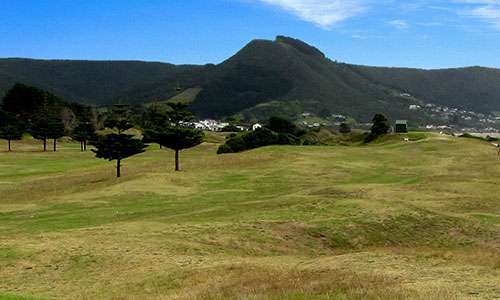
48: Kaitaia
Kaitaia Golf Club sits on the edge of 90-Mile Beach in sub-tropical Northland. Its west coast location is perfect for this bumpy links course, built in the dunes by a team of local farmers. The weather from the Tasman Sea can team up with the course to provide either enjoyable or challenging conditions. On a beautiful day, the views out to sea and the magnificent sand dunes at Reef Point will have every golfer’s camera out, but when the wind picks up, the course really shows its teeth. Exposed from almost all directions, the five par-3s and five par-5s make this course unique, picturesque and challenging.

47: Rotorua
Rotorua Golf Club, known locally as Arikikapakapa, which means “the gentle sound of plopping mud” in native Maori, is one of the only geothermal golf courses in the world. Located in the popular tourist destination of Rotorua, many holes play over and around both dormant and active thermal areas. Vents of steam are often seen during the round, either from the course itself or the nearby Pohutu geyser… the largest active geyser in the Southern Hemisphere. Built on pumice, the course is free-draining and easily walkable.
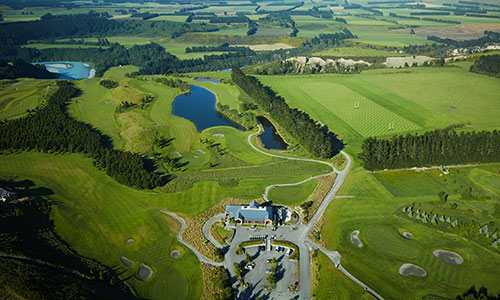
46: Terrace Downs
High-country golf with big views is on offer at Terrace Downs. Situated between the plains and the Alps, the resort course is located an hour outside Christchurch and is known as much for its views of the Rakaia River and Mt Hutt as it is for the winds that can pass across the course. Tree removal to the right of the short par-3 16th in 2014 opened up big views on a relatively short hole that demands an accurate shot from the tee.
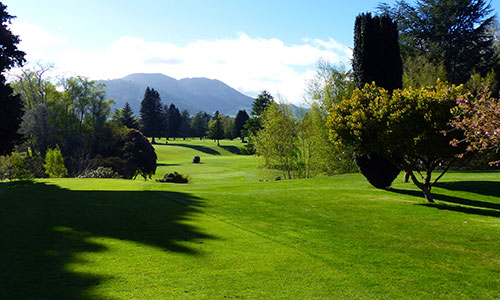
45: Taupo (Centennial)
Taupo Golf Club’s Centennial course, built in 1973, is the more significant of the two 18-hole courses that make up New Zealand’s only 36-hole facility. Primarily a parkland course, the geothermal aspects of the region do have a presence on the closing holes and golfers are often treated to vents of steam rising from the ground. It’s understood that the likelihood of golf in the area was uncertain, as the ground is primarily pumice and therefore questionable whether sufficient turf cover could be achieved.
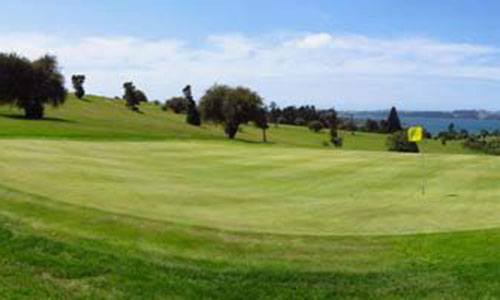
44: Waitangi
Waitangi Golf Club is located in the beautiful Bay of Islands and only a kilometre away from the historical Waitangi Treaty Grounds. With half the course looking over the waters of the bay, and the other across more iconic forest and bush, Waitangi is a pleasant layout paired with incredible scenery. A series of changes in 2011 included a renovation of the 11th hole, which brought the green site right to the coastline.

43: Wainui
Officially New Zealand’s newest 18-hole course, Wainui was built on rolling farmland and opened in 2017. From the modern clubhouse, one may get the feeling this is a resort course. However, once your round begins you will recognise that Wainui requires thought and skill to navigate. The course tends to play longer than the scorecard suggests, however several holes make driver off the tee a foolish choice. For a bit of extra fun, try the par-3 “Orchard Nine” after your round.
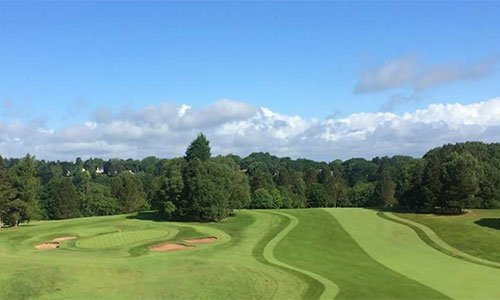
42: Rangatira
Rangatira Golf Club sits halfway between Wellington and Taupo on SH1. Often referred to as a “hidden gem”, the course is built on three levels, complete with an electric cable car that shuttles players from the 18th green up to the clubhouse. While the course offers sweeping views of the snaking Rangitikei River, the short, downhill, par-4 13th is a standout at 243 metres with two large pines guarding the entrance to the green.
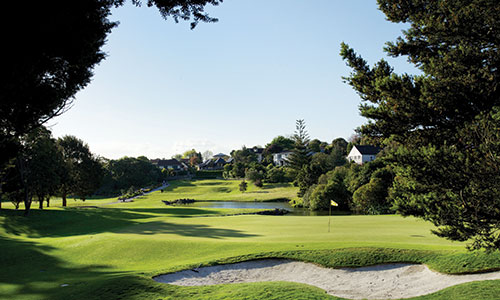
41: Remuera
Remuera Golf Club sits in the heart of one of Auckland’s most sought after suburbs. The 18-hole course is routed on primarily rolling, treelined terrain and has been undergoing small, steady upgrades for several years. A stretch of the newer holes – the 16th to 18th; a par 5, par 3, par 5 finish – don’t give up many strokes, and the recent addition of Top Tracer technology to the range have continued to see Remuera benefit from investment in the course and wider facility.

40: Formosa
The Sir Bob Charles-designed course at Formosa in Auckland hosted the 1998 New Zealand Open and boasts 16 holes with views of the water, Waiheke Island and Rangitoto. The downhill, 329-metre fifth hole is driveable and offers an excellent risk/reward opportunity with water running down the left-hand side. While golfers can choose the traditional mode of transport (car), the course is also accessible via ferry from Auckland’s CBD.
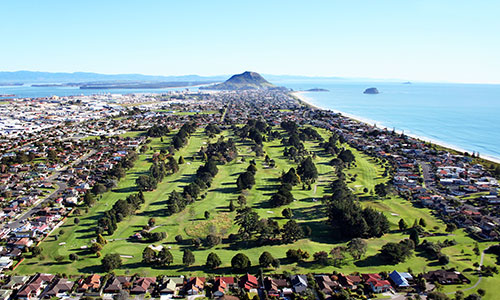
39: Mt Maunganui
Originally founded in 1935 on sand dunes next to “the Mount”, it wasn’t until 1947 that land was purchased for the current Mt Maunganui course, whose border is set back a mere 200 metres from the sea. With a sandy soil base, the course sits in the shadow of the extinct volcano located just a few kilometres to its north-west.
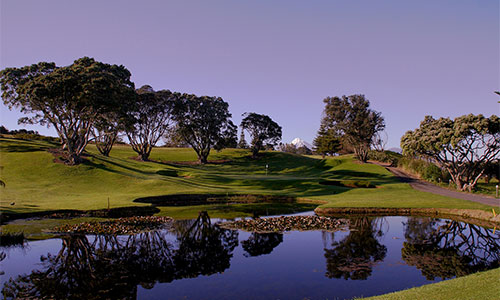
38: New Plymouth
Primarily parkland with a bit of a links feel, New Plymouth Golf Club’s Pohutukawa-lined fairways provide views of the Tasman Sea on one side and Mt Taranaki on the other. Ngamotu, as the locals call it, is Maori for “The Islands”, and refers to the islands that lie just off the New Plymouth shore. The course, which turns 107 years old in 2019, has been the venue for four New Zealand Opens. A unique feature of the course is the four par 3s that each play to a different direction on the compass.
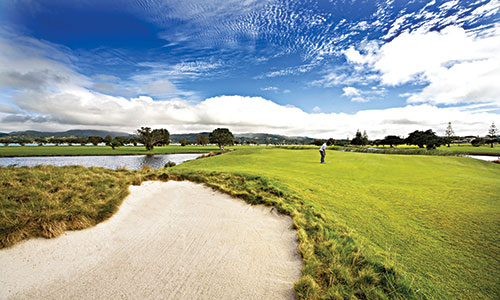
37: Omaha Beach
Omaha Beach Golf Club, a links-style resort course, was designed to make the most of its location and the gentle, undulating roll of its rural landscape. Bordered by the sea on one side and a natural estuary on the other, it features a Totara Grove adjacent to one hole, a stand of Kaihikatea providing shelter to a boardwalk that delivers you to another, with the estuary itself providing a new landscape, and challenge, as you progress around the course.
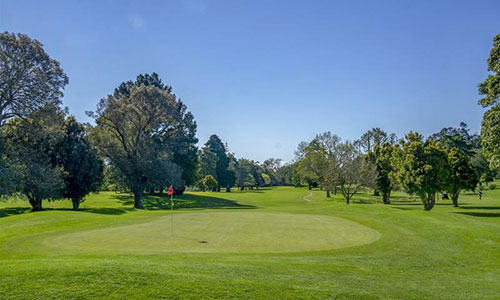
36: Whitford Park
Just 30 minutes from the Auckland CBD, Whitford Park Golf Club incorporates a strong stable of holes in a traditional Kiwi setting. The site of a former ostrich farm, the club’s 254 acres had a land cost of $180,000 in 1964 – a far cry from today’s value. With a stream winding it was way through parts of the layout, the par-71 course features 17th and 18th holes that have been known to wreck a scorecard or two.

35: Queenstown
With backdrops of the Remarkable Mountains and Lake Wakatipu, Queenstown Golf Club offers a unique opportunity to play on what is internationally regarded as one of the most picturesque golf courses in the world. Located on the Kelvin Heights peninsula, it is one of the most visible landmarks in Queenstown, which lies on its doorstep. The signature hole is the par-4 fifth hole, a risk/reward design framed on the left side by Lake Wakatipu with a fairway that doglegs to the left.
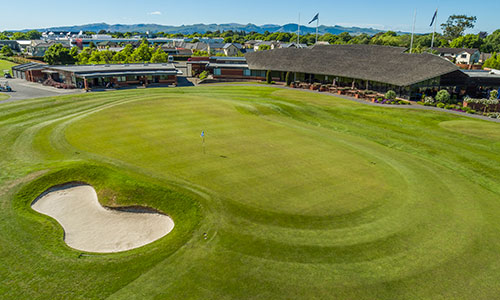
34: Russley
Treelined and manicured, Russley Golf Club is the epitome of what you expect from a golf course in “The Garden City”. Host of the 1985 New Zealand Open, won by none other than Corey Pavin, the course has hosted several more big names over the years, including fellow Major champions Tom Watson and Tom Kite. Russley’s existing layout is rumoured to have ties to Commander John Harris, of Wairakei fame. More recently, Greg Turner redesigned the back nine.

33: Invercargill
Invercargill Golf Club, founded in the late 1800s with design work completed in 1924, features treelined fairways and well bunkered greens. The relatively flat course provides some much appreciated length on the south-west corner of the South Island. At 6,036 metres and a Slope rating of 130, it is the longest, and most difficult club in the region, especially after the closure of nearby Oreti Sands.
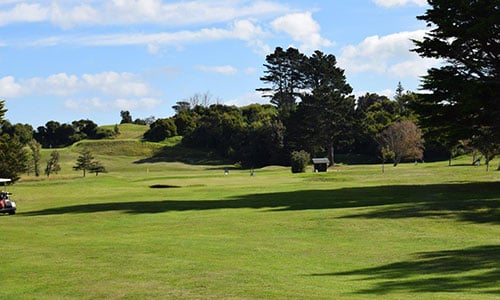
32: Wanganui
Wanganui Golf Club, a host of seven New Zealand Opens and established in 1894, it is one of the oldest clubs on our inaugural ranking. With a sandy soil that is relatively free-draining, Wanganui provides dry conditions year-round on a course that stretches to more than 6,000 metres from the back tees (at a par of 70).
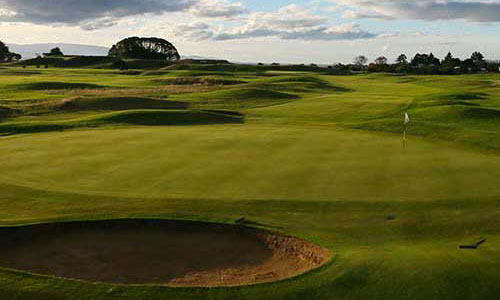
31: Nelson
Sandwiched between Nelson’s airport and the beautiful Tasman Bay, the 18-hole Nelson Golf Club course is considered to be among the best links layouts in the country. While the course comes as close as 70 metres from the airport’s runway, we find the interaction with aviation to be both charming and unique. After converting in about 1940 to an air force base – complete with gun placements around the course – once the war was over it was returned to the golfers, who have said the damage caused by the conversion actually added character to the course. More recently, significant tree removal and a further conversion to a true links has seen the club’s appeal to both members and visitors increase.

30: Waitara
New Plymouth’s Waitara Golf Club is a seaside gem and also likely our shortest course, playing just 4,756 metres for men with a par of 67. This course is as coastal as it gets, with the Tasman Sea unfortunately eating away the perimeter holes. That same sea, along with Mt Taranaki’s looming in the distance, provides spectacular scenery to go alongside a fun, firm, fast golf experience. Bumpy fairways and the use of natural contours sit alongside charming handmade signage at this course that epitomises the link between land and sea.

29: Chisholm Links
A classic Scottish-style links course with amazing views of the South Pacific Ocean, neighbouring beaches and the local region, the natural features of Dunedin’s Chisholm Links have provided a beautiful piece of land for golf. Considered by many to be among the best links courses in New Zealand, the undulating terrain and its coastal climate offset the lack of length.
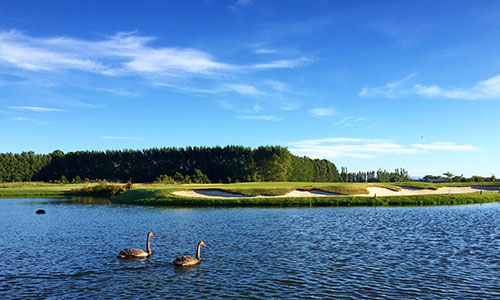
28: Pegasus
Pegasus Golf & Sports Club, host of the recent 2019 New Zealand PGA Championship, is fairly open, with generous landing areas on contoured fairways aimed at testing skill, strategy and execution. There are plenty of risk/reward options to consider on this Kristine Kerr design. Bold play can often be rewarded with plenty of birdie opportunities on the large, receptive greens. However, poorly executed plans will quickly lead to a double or triple-bogey.
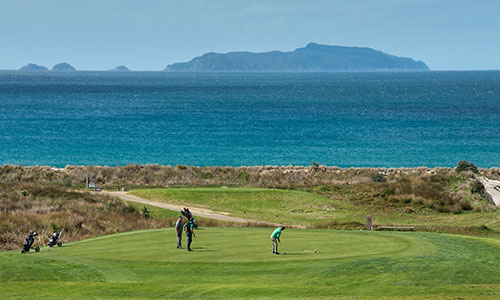
27: Waipu
Situated on the shores of the Pacific Ocean, Waipu is a coastal links layout featuring natural, bumpy terrain. It is one of the few courses in the country to offer water views from every hole. This naturally sand-based course is unaffected by weather and all but ensures playable conditions year-round. The 16th hole, a par 4 where the tee is the most elevated point on the course, is a great opportunity to capture the beauty of Waipu.
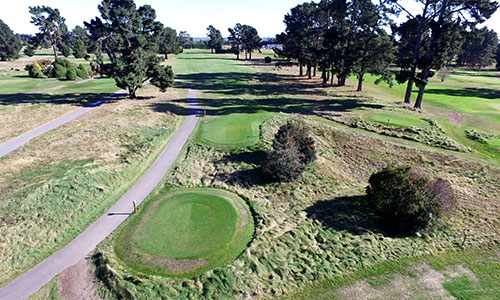
26: Harewood
Less than 15 minutes from the centre of Christchurch, the Woodlands course at Harewood Golf Club was remodelled by New Zealand golf Hall-of-Famer Greg Turner in 2012. Eighteen new greens and 18 new tees were built, and several areas out of play were converted to native areas. With deceptively undulating fairways, swale-protected surrounds and excellent contoured greens, the changes are still be hailed as ‘game changing’ for the course.

25: Waverley
Waverley Golf Club gained fame in 2016 when world-renowned course architect Tom Doak gave an interview singing the course’s praises. One of the few courses in our ranking that relies primarily on 300 sheep for keeping the fairways mowed, what Waverley lacks in length (it tips out at 5,537 metres), it makes up for in character. Located a few minutes off SH3 between Wanganui and New Plymouth, the course has views of Mt Ruapehu and Mt Taranaki.
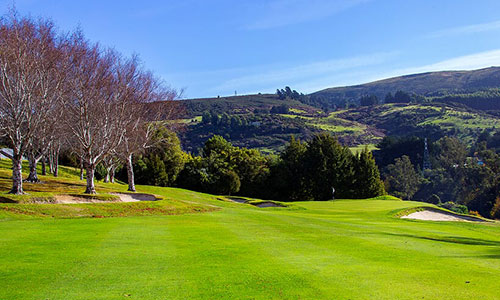
24: Otago
The oldest club in New Zealand (and one of the oldest in the Southern Hemisphere), Otago Golf Club offers views of the city of Dunedin and beyond to the South Pacific. It has hosted seven New Zealand Opens as well as many golf legends, such as Gene Sarazen, Arnold Palmer and Gary Player. Its signature hole is one of the best known in New Zealand. Named ‘The Glen’, this par 4 is a sweeping downhill dogleg. Palmer drove the green in an exhibition match with Sir Bob Charles in 1966.

23: Manawatu
Manawatu Golf Club borders the banks of the Manawatu River in Palmerston North. Built in 1895, the club claims the title of the oldest golf course in New Zealand and has a proud history of hosting New Zealand’s top professional and amateur events, including five New Zealand Opens, eight New Zealand Amateurs and various other national championships. Treelined with manicured fairways, the course includes 50 white sand bunkers.
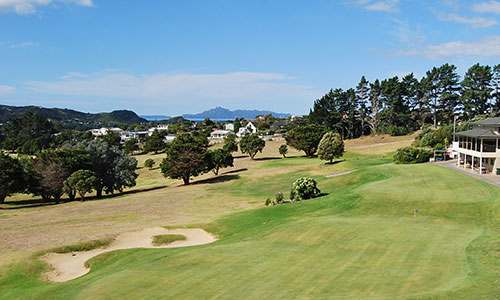
22: Mangawhai
Mangawhai Golf Club sits at the entrance to Northland and is just up the road from Tara Iti. Mangawhai (translated as “the estuary of the stingray”) is a sand-based links course with fairways that wind through a setting made for golf. Large, undulating greens provide a consistently quick pace with an abundance of natural hazards, demanding a quality of golf that favours finesse over raw power.
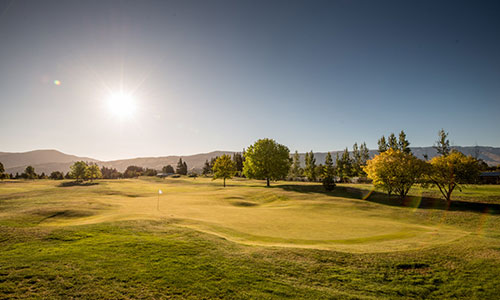
21: Cromwell
Cromwell Golf Club is considered by many to be the finest inland links course in the country. The club has come a long way since its formation in 1903, when one of the hazards was an old mineshaft. The facility had a $1 million upgrade performed in 2009 by Greg Turner. Cromwell’s low rainfall, 2,200 hours of sunshine per year and sand-based fairways combine to guarantee year-round dry conditions underfoot. The signature hole is the par-4 18th, named ‘Snake Gully’, which requires a shot through a valley with steep bunkers.
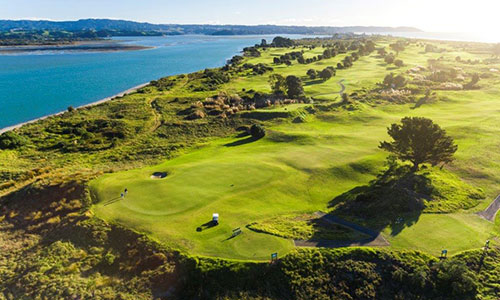
20: Ohope
The layout at Ohope International Golf Club in the Bay of Plenty is one of the best examples of a ‘hidden gem’ in New Zealand. A gorgeous seaside links course, with bumpy terrain and incredible sea views, the course is natural, raw and rustic. Golfers who can control their ball flight and deal with the changing wind conditions will score well at Ohope. As an added bonus, golfers are treated to views of White Island on a clear day.

19: Hastings
Hawke’s Bay most sought-after course, Hastings Golf Club is a parkland, treelined course that was founded in 1898. The course features well-manicured fairways and evenly paced greens. A new driving range opened in 2015, and there is a four-hole short course for juniors and beginners. The signature hole is the par-4 fifth hole, named ‘Flaxmere’, which features a sharp dogleg and a tricky green.

18: Clearwater
For more than 15 years, Clearwater, the course designed by John Darby and New Zealand golf legend Sir Bob Charles, has proven itself as a venue for international professional golf. This was demonstrated most recently by Lydia Ko, who won back-to-back New Zealand Women’s Opens at Clearwater in 2015 and 2016. Water is a strong feature of the course, particularly on all four par 3s as well as the long par 4 finishing hole.

17: Gulf Harbour
Much of Gulf Harbour’s ranking position can be attributed to a recent investment in staff and equipment that has revitalised this Robert Trent Jones Jnr layout that sits prominently on the Hauraki Gulf. The site has good vertical movement and several excellent risk/reward holes. The back nine is the standout here, capped off with the picturesque 16th hole, a par-4 that begs for you to cut the corner and a green that provides sweeping ocean views.
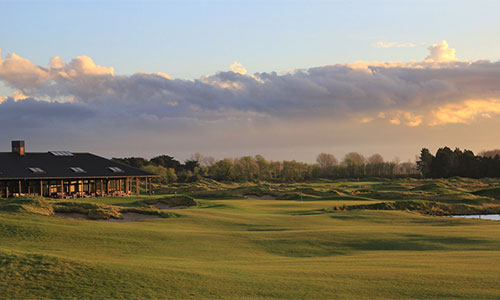
16: Windross Farm
One of the country’s newest courses, Windross Farm officially opened in 2017 and is the work of Brett Thompson and golf course consultant Phil Tataurangi. Located on a former potato farm, Windross flew onto New Zealand’s golf scene by hosting our first LPGA Tour event in its opening year. The inland links course is unlike anything else we’ve seen in Auckland, with subtle mounding, width off the tee and detailed shaping around the greens.
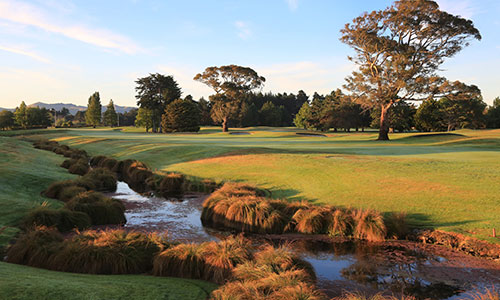
15: Christchurch
Christchurch Golf Club has the distinction of being the second oldest course in New Zealand (behind Otago Golf Club), and the sixth oldest outside the United Kingdom. The latest round of course enhancements was completed by the late, great Australian golf legend Peter Thomson, winner of five Open Championships. Known for its undulating fairways and superb presentation, Christchurch has held numerous New Zealand Opens and played host to the 1990 Eisenhower Trophy. A brand new clubhouse opened in February 2016.
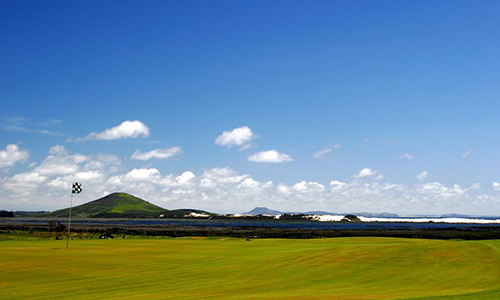
14: Carrington
The northernmost course on our list is Carrington Golf Club, which is situated on more than 1,300 hectares on the Karikari Peninsula. The facility includes the 18-hole Matt Dye-designed course with resort-style accommodation. The layout offers one of New Zealand’s longest par 5s at 605 metres and one of the country’s shortest par 3s at 113 metres. The signature hole is the par-4 15th overlooking Karikari beach and the Pacific Ocean.
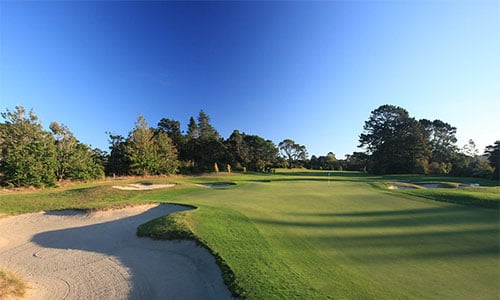
13: Titirangi
Located close to the centre of Auckland, Titirangi Golf Club is New Zealand’s only course designed by Dr Alister MacKenzie. It was during a visit in the late 1920s that MacKenzie drew up what we see today, and although the club has completed small projects throughout the years, the original routing is still intact. Less than 15 kilometres from Auckland’s CBD, Titirangi is set among an abundance of native bush with green complexes that will challenge the best of short games.

12: Muriwai
The west coast of Auckland’s black sand beaches produced Muriwai Golf Links. The layout sits alongside the Tasman Sea, which produces the perfect drama for this windswept links course. Dry in winter and irrigated in summer, the course is a particular winter favourite for the Auckland market. One of the fairest tests of golf in New Zealand, Muriwai is revered for the way it rewards good shots and punishes bad ones.

11: Royal Wellington
A traditional parkland layout that borders the Hutt River, trees and birds are in abundance at Royal Wellington Golf Club, the course that hosted the 2017 Asia Pacific Amateur Championship. Located on the current site for more than 100 years, it became New Zealand’s first royally designated club in 2004 to coincide with the 250th anniversary of the R&A. The course underwent a major redesign from 2011 to 2014 under the direction of architects Greg Turner and Scott Macpherson.

10: Arrowtown
Built on a little more than 56 hectares, not a bunker can be found on the Arrowtown Golf Club course (however there is one on the property… at the practice area), but what is found is an abundance of schist. The 5,409-metre, par-71 layout may seem short, but it’s not just length the course lacks, but width too. The narrow fairways and tiny greens require accuracy above and beyond what is required elsewhere in New Zealand.
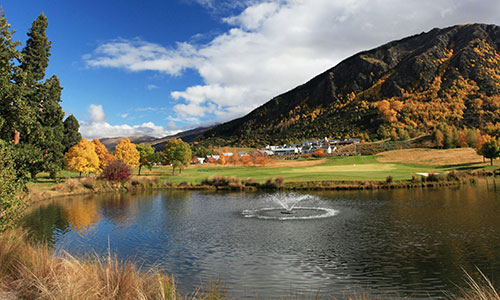
9: Millbrook
Millbrook features three distinct nines with a fourth currently under construction. When Japanese businessman Echii Ishii chose a location near Arrowtown in the early 1990s, the golf world questioned his decision. Fast forward 25 years and Millbrook is a New Zealand success story. Our most celebrated resort, Millbrook combines golf, accommodation, activities, and dining in a mountain amphitheatre. A co-host of the New Zealand Open, Millbrook is expecting the new 18-hole course to host the final round of the tournament in 2021.

8: Paraparaumu
The ‘Spiritual Home of Golf’, many in the golf world consider our eighth-ranked course the greatest links course in the Southern Hemisphere. Built in 1949 by Alex Russell, a one-time partner of Dr Alister MacKenzie, Paraparaumu Beach Golf Club has hosted a record 12 New Zealand Opens. The course is built on rolling volcanic sand dunes and consistently plays as it should: firm and fast. Conditions are nothing short of excellent. Don’t let the 6,038-metre distance fool you; this par 71 can be one of the toughest tests of golf in New Zealand, and also the most enjoyable.

7: Wairakei
Wairakei Golf + Sanctuary is a perennial favourite of all New Zealanders. Recent changes to the first hole, an expanded clubhouse and the addition of the endangered North Island Brown Kiwi complement the endangered Takahe that can be found roaming the fairways of this parkland gem. Super conditions and a 25-minute drive to Kinloch should ensure that everyone makes at least one visit to Taupo each year.
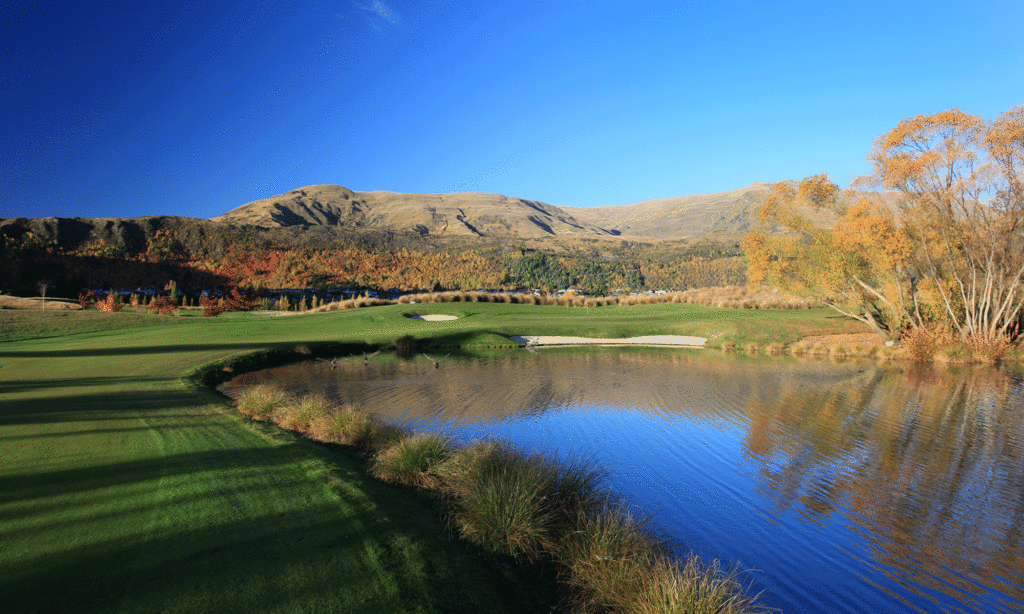
6: The Hills
Sir Michael Hill’s Queenstown gem remains our nation’s sixth best course, fresh off its co-hosting of the 100th New Zealand Open. The question has often been asked, is this a golf course in a sculpture park, or a sculpture park on a golf course? We’ll leave it to those lucky enough to play this private club to decide, but what we can all agree on is that this rocky site in Arrowtown has provided great drama over the years. The newest addition to The Hills is a par-3 course, named ‘The Farm’, and designed by Australian Darius Oliver.
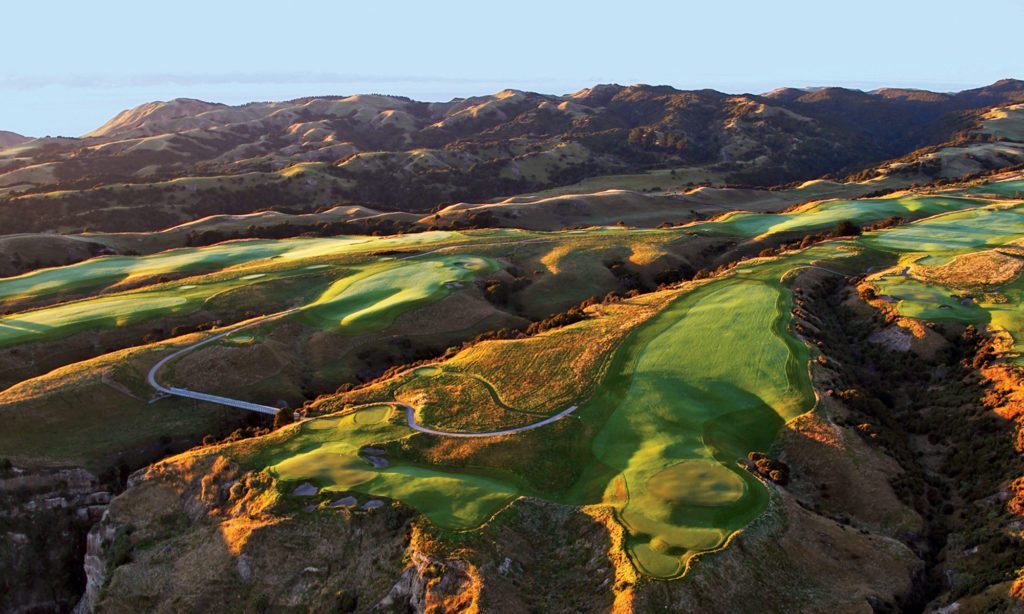
5: Cape Kidnappers
The clifftop Cape Kidnappers offers golf drama hard to find elsewhere. The non-descript entrance gate leads to a 10-kilometre driveway that gives glimpses of a course that has been included in Golf Digest’s World Top 100 since its debut in 2004. Cape Kidnappers is Tom Doak’s first New Zealand course, and gives him the distinction of having two courses among our top five…
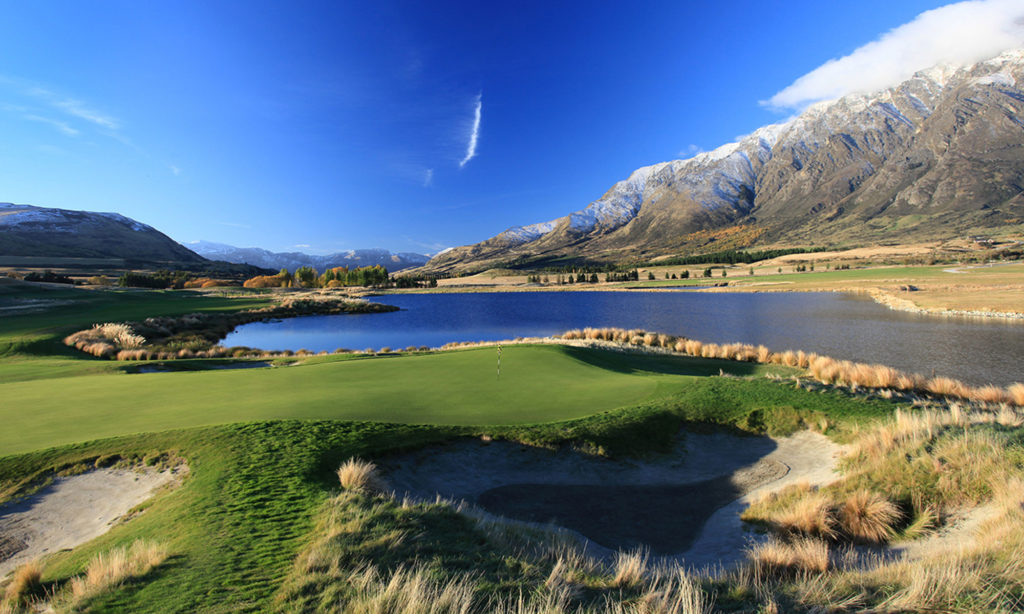
4: Jack’s Point
The South Island’s best course is Jack’s Point. Sitting on the shores of Lake Wakatipu, this is one of four Queenstown courses in our top 30. It’s unlikely many of our readers haven’t played Jack’s Point, but if you have missed out on this gem, it should be high on your priority list. With a course that rises and falls along the rugged terrain, Jack’s Point provides two stunning backdrops, with the lake to one side and the Remarkables to the other.

3: Kinloch
The North Island continues to dominate the top of our list, with Taupo’s Kinloch Club coming in at No.3. New Zealand’s only Jack Nicklaus Signature design, many describe Kinloch as “unlike any Nicklaus course you’ve ever seen”, and they’re right. The fescue-covered fairways have nary a flat spot on them, with the course playing firm and fast year-round. While flat lies are rare at Kinloch, the superb conditions are constant. A recently launched caddie program will further enhance Kinloch’s appeal.

2: Kauri Cliffs
Our second-best course also sits north of Auckland, in the subtropical Bay of Islands. Considered by many to be the prettiest golf course in the world, the back nine at David Harman’s Kauri Cliffs tests every club in the bag. Its high ranking could be partly due to the upper North Island’s growing reputation for superb golf, or it may be that Rees Jones’ subtle, yet significant changes in 2014-’15 have finally paid dividends. Either way, Kauri Cliffs’ position on this list, and in the wider World Top 100, remains a deserved accolade for one of the courses that has put New Zealand on the global golf map.

1: Tara Iti
Our No.1 course is likely no surprise. Tom Doak’s magnificent seaside links of Tara Iti have been making headlines since before opening day. Built on sand dunes that were previously home to a pine forest, the wall-to-wall fescues, soft edges all around and an abundance of sand but no ‘bunkers’ mean the course is unlike anything else in the world. Caddies are compulsory, but the course’s gentle elevation changes make for an easy walk. While the course is private, long-standing rumours swirling about two new public courses on-site were recently confirmed, including a second Doak course and a Bill Coore design. Tara Iti is a masterpiece and deserving of our No.1 spot as it furthers New Zealand’s growing reputation as a serious golf destination.



